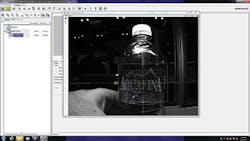Machine Vision Software: Image classification software goes on show at Automate
Many machine vision systems do not require precision measurements of parts to be made. In bottle sorting applications, for example, it may only be necessary to determine the type of bottle that is present. Once determined, the machine vision system can then be used to control electromechanical actuators to sort each bottle type onto specific conveyors or bins.
If such products can be readily distinguished by color, for example, then a simple color analysis program can be used to separate them. In many applications, where the lighting may be uncontrolled, this task is more complex and image features must be first extracted and then properly classified to perform the sorting task.
Choosing which features and classifiers for a particular task may be performed by systems integrators. Using software packages such as HALCON from MVTec Software (Munich, Germany; www.mvtec.com), for example, developers can choose from a range of feature extraction tools and classifiers such as neural nets, support vector machines (SVMs), Gaussian mixture models (GMM) and k-nearest neighbors (k-NN).
Similarly, the perClass software from PR Sys Design (Delft, The Netherlands; www.perclass.com) offers classifiers such as k-NN, neural networks, Random Forests, and SVMs and allows the software developer to choose the best features within the image data for classification, train the types of classifiers and optimize their performance.
To implement image classification, supervised or unsupervised learning techniques can be used. In the former, the classifier will be presented with known good and/or bad objects. In applications such as bottle sorting, the number of objects that need to be presented may be low.
In a demonstration at this year's Automate, for example, Datalogic (Telford, PA, USA; www.datalogic.com) demonstrated how its pattern searching tool could be used to rapidly identify and sort bottles. After presenting a test bottle to the system, key points in the image are first automatically extracted, relieving the programmer of determining which image processing operator should be used. These key points are then presented to a k-d tree classifier allowing newly presented bottles of the same type to be rapidly classified.
Developers using CVB Manto from Stemmer Imaging (Puchheim, Germany; www.stemmer-imaging.de) also do not need to select the relevant features in an image. Using extracted texture, geometry and color features, captured data is then presented to an SVM for classification. Similarly, the NeuralVision system from Cyth Systems (San Diego, CA, USA; www.cyth.com) is designed to allow machine builders with no previous image processing experience to add vision to their systems (see "Machine learning leverages image classification techniques," Vision Systems Design, February 2015; http://bit.ly/1KLvDSx).
While simple image classification tasks may require just a few objects to be classified, other more complex tasks may require hundreds of objects to be presented to the vision system resulting in many man-hours of supervised learning. Because of this, companies such as Pallas Ludens (Mannheim, Germany; www.pallas-ludens.com), have leveraged the power of crowd-sourcing to alleviate the task (see "Crowd sourcing speeds image classification development," Vision Systems Design, March 2015, http://bit.ly/1xvJr2V).
Rather than train known good and bad parts, developers can choose to simply present known good images to image processing and classification software. In this manner, any part that deviates from a known good classification will be automatically flagged by the system.
One of this year's Vision Systems Design's Platinum Innovators award honorees - ViDi Systems (Villaz-St-Pierre, Switzerland; www.vidi-systems.com), for example, has recently shown how its Vidi Suite software can be used in this way to automatically optically inspect welding seams. In operation, the software trains on a set of known good samples, creates a reference model and then automatically identifies defective welds.
At Automate, Sightline Innovation (Toronto, ON, Canada; www.sightlineinnovation.com) also demonstrated how it's newly introduced Sightline Verify software package had been used to check the quality of the vertical supports of an automobile's window by automatically learning the characteristics of the part and flagging any identified defect.

